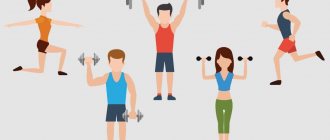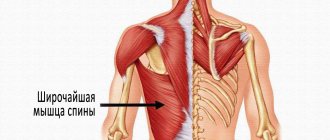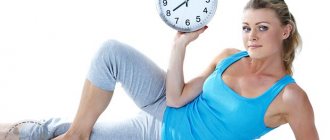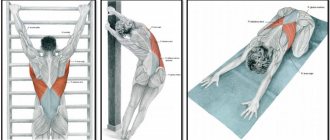A set of exercises for the lower body
Now let's talk in more detail about exercises on this miracle ball. One of the main exercises in this series is squatting with a ball over your head. This is a regular squat, but with your arms extended upward and holding a huge ball. This exercise perfectly strengthens the muscles of the arms and legs.
The next type is a squat with emphasis on the wall. The fitball is squeezed between the wall and the body. During squats, it rolls along the back from bottom to top - from the lower back to the shoulders. This is how the quadriceps muscle is trained. The exercise, like the previous one, must be repeated 10-15 times.
Exercises of this type include: squats with a fitball clamped between the knees, slow squats with arms extended forward holding the ball, lunges, etc.
If the descriptions of the classes are not enough, you can watch video exercises on a fitball. They will show you all the details.
Reviews about using a fitball for the back
Elena, St. Petersburg, 25 years old:
I started working out with a fit ball on the recommendation of a physical therapy doctor. I have a protrusion of the cervical spine. I added training to Dikul’s exercises. A month later I felt good relief in the cervical spine and lightness. My head became clearer, and it became easier to sit through everyday office life. A very effective thing, I recommend it!
Maxim, N. Novgorod, 32 years old:
I went to an orthopedist for a herniated disc in the lumbar region, went for massages, and even visited the Bubnovsky center. It seems like he is on the mend, but somehow very slowly. On the advice of a therapist, I went for a consultation with a fitball instructor. I became interested in the program, made a schedule and started studying. At first it was hard, but after two weeks I felt how my lower back was unloaded, walking, sitting and especially lying down became much easier. I will continue in the same spirit)
Exercises for the back and spine
Doctors usually recommend that the list of such exercises include stretching, straightening, pulling, twisting and “flying on a ball” (video lessons with examples of their implementation are widely distributed on the Internet today).
Stretching
- kneeling position with a ball placed in front of you;
- the body bends parallel to the floor, hands fall on the ball;
- exhale - the back rises and rounds, the fitball rolls towards the body, the head drops towards the chest;
- with even breathing, the body position is maintained for 30 seconds;
- inhale - return to the original position, wait another 30 seconds.
Straightening
Execution (recommended next to a wall to restore balance if necessary):
- the body is relaxed, lies freely on the fitball on the stomach, arms and legs hang down;
- inhale - slow straightening with an attempt to straighten the body parallel to the ground;
- exhale - also slowly return to the starting position.
Pull
Stretches the spine, helps fight osteochondrosis and the initial stages of hernia.
- pose – sitting on a fitball, knees bent, hands resting on the wall;
- inhale - the ball rolls back, with a simultaneous forced maximum extension of the spine (since the hands remain on the wall in the same position);
- with even breathing - 2-3 minutes in an extended position;
- exhale - return to the starting position.
Twisting
Aimed at developing flexibility of the spine (especially for problems with back pain) and strengthening the lower back.
- back - on the floor, bent legs thrown over the fitball, support with outstretched arms at the sides;
- trying to move only the hips and pelvis, roll the legs with the ball to the left and right so that the knee reaches the floor (repeat 10-15 times).
Ball Flight (or "Flying Superman")
- starting position - with your stomach on the fitball, with your arms and legs resting on the floor;
- inhale – the arm and the opposite leg are extended (that is, for the left arm – the right leg and vice versa);
- 4-5 seconds delay;
- exhale - return to the starting position, after which the repetition occurs with a change of arms and legs.
Exercises with a ball for the spine and their types
It's no secret that the back muscles must have not only flexibility, but also great strength. This is necessary, first of all, in order to optimally support the spine itself.
Weak muscles cannot take on the loads and stress placed on them. This means that joints and ligaments, which are not as well supplied with blood as muscles, work instead.
The importance of ball exercises for the spine
Over time, the joints and ligaments gradually wear out, which can lead to some damage to the muscle tissue and the presence of chronic back pain.
Therefore, exercises with a ball for the back and spine are one of the main ways to prevent and treat back problems.
As a rule, they are aimed at strengthening muscles and helping to get rid of pain, while increasing the ability of muscle tissue to take on the bulk of stress and load, thereby making it easier for the joints and ligaments to work directly.
Types of exercises with a ball for the spine
- It is necessary to fix the fitball between the lower back and the wall, pull the pelvis forward, but so that the back is straight. Place your legs at the width of your pelvic bones, and place your feet parallel to each other. Next, you should begin squats, while the fitball rolls over your back. Then you need to return to the starting position.
This exercise should be repeated fifteen to twenty times. It works great on the buttocks and muscles in the front of the thighs, as well as on the muscles in the spine.
You need to lie on top of the fitball, with your toes pointing to the floor and your heels pointing to the wall.
Hands should be placed behind your head and maintain balance, while raising your torso along the floor. This exercise is repeated fifteen to twenty times. It has a good effect on the buttocks, as well as the lumbar muscles and back.
You should lie on your stomach on the fitball and rest your hands on the floor.
Then lift your legs off the floor, while trying to fix your thighs parallel to the floor. After this, you need to bend your knees, your heels should be close, and your toes should be apart. Here you need to make sure that the ball does not move from its place. This ball exercise should be repeated up to fifty times. It is designed for the buttocks and back.
You need to take the fitball in your hands so that it is near your chest, but it should not touch it. Then you should squeeze it with your hands, using only the chest area. You need to perform such compressions from fifteen to twenty times. This exercise effectively affects the pectoral muscles and upper back. You need to squat so that your thighs are parallel to the floor. Then fix the fitball with your lower back and put your hands behind your head. After this, using the press, you should move the torso from one side to the other.
Rules for practicing with the ball
Spinal stretching exercises can really give an excellent healing effect and help a person get rid of unpleasant, aching pain in this area. However, there are some rules that must be followed. They are as follows:
- for beginners it is not allowed to do more than five approaches at a time, you need to increase the load gradually;
- to complicate the activity, you can pump the ball more strongly, this will allow it to be less stable and will force the muscles to strain even more in the process of performing all kinds of exercises;
- There is no need to be afraid that the ball may burst and stun, since it is made of reliable and, as a rule, high-quality materials, and if any damage occurs, it will simply deflate.
Have you ever experienced unpleasant discomfort in your joints or annoying back pain? Judging by the fact that you are reading this article, you or your loved ones are faced with this problem. And you know firsthand what it is:
- inability to move easily and comfortably;
- discomfort when going up and down stairs;
- unpleasant crunching, clicking not of your own accord;
- pain during or after exercise;
- inflammation in the joints and swelling;
- causeless and sometimes unbearable aching pain in the joints...
You've probably tried a bunch of medications, creams, ointments, injections, doctors, examinations, and, apparently, none of the above has helped you...
And there is an explanation for this: it is simply not profitable for pharmacists to sell a working product, as they will lose customers! It was precisely this that Russia’s leading rheumatologists and orthopedists jointly opposed, presenting a long-known effective remedy for joint pain that actually heals, and not just relieves pain! Read an interview with a famous professor.
Insurance and safety issues
The ball is a round thing, it rolls on the floor. Accordingly, you can fall from it. For some, this fall will be just a funny event, but for others it will be a reason to go to the doctor.
Therefore, for elderly people and those who are not confident in themselves, it is better to use insurance. Anyone can insure. Just ask him to lightly hold your feet, for example.
The fitball relieves stress from your back. This is a huge plus of working on your back with a hernia. Since the load is removed, the pain syndrome is also relieved.
With a hernia, even hyperextension can lead to pain of varying degrees. On a fitball this is not felt so acutely.
Infants and fitball
The main element when doing physical education with infants is strengthening the vestibular apparatus. During exercises on a fitball, passive swimming occurs, while children consolidate kinesthetic, vestibular and visual impulses. This way of exploring the world is excellent and safe.
In such young children, the “flexion reflex” often works, so exercises on a gymnastic fitball allow the abdominal muscles to relax. At the same time, breathing and digestion are improved, the functionality of the adrenal cortex and other abdominal organs is stimulated.
It is also useful for children to do exercises with a fitball - it will strengthen their body
The first classes should begin with a light gymnastic warm-up, moving on to more complex exercises. This will allow you to gradually strengthen the muscles, develop the flexibility of the vertebrae, and normalize the functionality of the nervous system without overload and harm to the baby.
For whom will fitball be useful?
First of all, a fitness ball is necessary for people experiencing pain in the spine. For hernia, osteochondrosis, exercise on a fitball will be very useful.
For athletes, this is a good way to relieve stress on the back after a hard workout. For older people, this is an opportunity to safely strengthen the muscles of the lower back, back and abdominal muscles both at home and in the gym.
For people with disabilities who have difficulty moving, this is a chance to exercise.
Exercises with a ball for the spine
Most spinal problems are caused by excess weight, walking in high heels, heavy bags or improper loads, and a sedentary lifestyle. The spine does not like both immobility and excessive physical activity. Many people who spend hours sitting at a computer or in a car suffer from neck or back pain.
To reduce back pain, and eventually get rid of it completely, you need to relax and strengthen the abdominal and back muscles, create a natural muscle corset that supports the spine in the correct position. An excellent assistant in solving this problem will be a large gymnastic ball, for which there is a whole range of exercises for the spine.
In order to achieve sustainable results, it is necessary to systematically perform an appropriate set of exercises with a spinal ball, aimed at relaxation and development of the supporting muscles of the back, neck and abdomen.
Relaxation ball exercises
Strong and flexible muscles of the back and abdomen form a natural corset and keep the spine in the correct position. Weakened muscles, on the contrary, lead to incorrect position of the skeleton, which increases pressure on the sacrum and intervertebral discs.
Wear and tear of the spine, especially its moving parts, occurs at an accelerated pace in such a situation. To correct this problem, gymnastics, swimming and exercises in water, as well as Nordic walking and Pilates are well suited.
A gymnastic ball, an inflatable ball with a diameter of more than half a meter, provides good therapeutic effects. Exercises with a ball for the spine relieve muscle tension, massage the back, and help strengthen the muscles responsible for maintaining correct posture.
For those with osteochondrosis
Dystrophic disorders in articular cartilage, which are called osteochondrosis, affect more and more people every year. This is due, first of all, to a sedentary lifestyle and poor diet, as well as improper stress on the spine. Currently, even middle-aged people experience osteochondrosis.
Osteochondrosis can be treated!
ORDER VIDEO COURSE “Healthy back and joints. Goodbye melancholy, hello youth” at the link≥≥
You will receive a set of physical therapy exercises, available at any age, that will help get rid of osteochondrosis and joint pain!
Good health to you!
How to start training with the ball correctly?
Before you start exercising with the ball, you should carefully read the following recommendations.
- There is no need to try to try out the entire course of exercises with a fitball from the very first day - you need to do everything gradually.
- First, it is best to familiarize yourself with the ball and its structure in detail. Sit on it and slowly jump. Performing such simple movements will help you learn how to balance on the ball.
- The ball must correspond to the height of the person who works with it - only then exercises on the fitball will be beneficial and enjoyable.
- While doing the exercises, you cannot hold your breath: you need to breathe deeply and measuredly.
- Before you start doing the exercises, it is better to warm up in advance, for example, with a little gymnastics or running in place. This will prevent muscle strain, warm up the body and allow you to achieve greater results.
It is worth following certain rules when performing exercises.
Let's get to know the fitball better.
- During the first lesson, it is necessary to conduct a general “acquaintance” with the simulator, learn about its size, functions and benefits. Sit on the ball, while trying to keep your posture straight. You can try simple exercises such as squats on a ball or lying down.
- The next stage is a slight swing on the ball, while you need to maintain balance and keep your posture straight. This allows you to improve coordination and balance.
- The third stage is to begin performing therapeutic and preventive exercises, which also includes stretching.
- The final stage is to consolidate the skills acquired during the day. All stages are repeated in turn.
Massage back trigger points with a tennis ball
Watch this video as certified yoga instructor Ariel Kiley, who helped develop this massage, starts her day with a sequence of exercises.
Perform each step in this sequence for 90 seconds to 2 minutes, moving from one movement to the next.
“Each person must find their own time to take these steps,” Miller says. “Basically, you should do the exercise until the tension subsides and the pain disappears.”
Requirements for beginners
List of rules for practicing on the ball:
- Comfortable clothes and shoes.
- Long hair in a bun or ponytail.
- Quiet and spacious room, without strangers.
- Mandatory 15-minute warm-up before main exercises.
- Yoga no more than 30 minutes to begin with (not including warm-up).
- Fitball according to recommended size: taken into account depending on height.
- A glass of water near the training area. You cannot leave the comfortable state of peace and quiet room.
- It is advisable to turn on a relaxing and monotonous melody.
Before training, be sure to drink water and leave breakfast for later. After home practice, you should take a contrast shower to speed up your metabolism and turn on your metabolism.
Selection rules
The main rule is that in this matter it is better not to focus on cheapness! The fact is that a cheap ball can be useless, inconvenient and can even harm your health.
Key parameters of a gymnastic ball:
- Pressure resistance due to the elasticity of the projectile and the strength of the material. A high-quality ball can withstand weight up to 300 kg. If exercises on the ball will take place in combination with dumbbells, then you will need a ball for strength training.
- Material. Ideally, the ball should be made of polyvinyl chloride or latex. Cheap balls feel cold to the touch. The hand slides unpleasantly over the projectile. When pinched, there are many folds left on them. This is low quality material. If, after pressing the surface with your hand, it bounces back slightly and a little heat emanates from it, this is a quality item. And a good fitball should have a good antistatic effect, its surface should not be porous. Also, the surface must be perfectly smooth, without protruding seams, and the nipple must be properly pressed inward.
- Safety. If the ball is damaged, it should not explode. You need to make sure that it has a special anti-burst system that will ensure smooth deflation.
- Ball size. Everything is individual and related to height and weight. To understand your required size, you need to do a certain test: sit on a chair and measure the distance between the knee joint and the floor. The result obtained will indicate the appropriate ball diameter.
- Ball color. Of course, this is a matter of taste, however, it is worth considering some features of the effects of colors. Blue and green colors can calm the nervous system and lower blood pressure. Yellow color acts as a psychostimulant. Orange is an antidepressant. Red is an immunostimulant.
- Ball set. High-quality fitballs must have a pump included in the kit, since inflating the ball is not an easy task!
Stories from our readers! “I cured my bad back on my own. It's been 2 months since I forgot about my back pain. Oh, how I used to suffer, my back and knees hurt, lately I couldn’t really walk normally... How many times I went to clinics, but they only prescribed expensive pills and ointments, which were of no use at all.
And now it’s been 7 weeks, and my back joints don’t bother me at all, every other day I go to the dacha to work, and it’s a 3 km walk from the bus, so I can walk easily! All thanks to this article. A must read for anyone who has back pain!”
An important point is the correct choice of ball, which is necessary to achieve optimal load on muscles and joints. Usually, the determining factor when choosing is the height of the athlete, which is why among specialists the following ratio of the latter to the size of the fitball is common:
- up to 1 m 50 cm – 45 cm;
- up to 1 m 65 cm – 55 cm;
- up to 1 m 85 cm – 65 cm;
- up to 2 m – 75 cm;
- more than 2 meters – 85 cm.
Contraindications for use
Despite the fact that it would seem that a gymnastic ball is universal and effective, there are also contraindications to exercising with it.
- Presence of intervertebral hernia.
- Skin diseases.
- Heart dysfunction.
- Spinal injuries.
- Difficult pregnancy.
- Sclerosis.
- Hemangioma of the vertebral sections, which can lead to rupture of tumors, leading to their growth.
After surgery, you should also be careful about exercise. In this case, all permissible loads should be prescribed only by a doctor.
There are certain contraindications for exercises with a gymnastic ball, so it is better to consult a doctor before starting training.
No matter how easy and necessary physical exercises on a ball may seem, consultation with a specialist will never be superfluous.
Exercises with fitball
Exercises on a gymnastic ball can be started at any age; there is even a separate type of exercise therapy for the development of the vestibular system in infants, in which a fitball is used. However, exercise therapy with a fitball for children must be carried out under the supervision of adults; the age group from 5 to 7 years can practice for half an hour. For children from 3 to 4 years old, the total duration of classes is recommended no longer than 20 minutes, due to high fatigue.
Important! Due to the fact that the bones in children are quite soft and the ligaments are plastic, in order to avoid injuries and sprains, precise implementation of all precautions is required
The set of exercises consists of:
- warming up, warming up (performed without a simulator);
- stretch marks;
- directly to the medical complex;
- relaxation (cooling down).
There are a number of exercises that can be performed on a gymnastic ball if you have problems in the back area. The complex below is universal. It allows you to work out most problems and strengthen your back muscles as effectively as possible:
- Stretching. It is performed as follows: on the floor, in a sitting position on your heels, the ball is placed directly in front of you, holding it on top with your palms. A deep lean forward is performed, while the ball rolls to the distance of outstretched arms, the forehead rests on the surface of the fitball. Hold for 10-12 seconds, return to the starting position.
- Straightening. Works well to strengthen the back and abdominal muscles. The starting position is lying on the ball, the fitball is under the stomach, the knees rest on the floor, the hands hug the apparatus, the head is lowered. As you inhale, the torso slowly straightens, resting your toes on the floor, the goal is to stretch out as parallel to the floor as possible, hold for 7-8 seconds, and while exhaling, take the starting position.
- Pulling. An excellent exercise for osteochondrosis, for the prevention of hernia and at its onset. Sit on the fitball on top opposite the wall, knees at right angles to the floor, palms of your arms extended above your head resting on the wall. As you inhale, the ball is pushed back, your back is extended as much as possible. For best results, stretching continues for up to 3 minutes, breathing evenly. Then - return to the starting position.
- Twisting. Helps develop back flexibility, relieves salts, and relieves minor pain. Lying with your back on the floor, place your legs bent at the knees on the ball. As you exhale, rotate the sword to the right, to the starting position, then to the left. When performing, try to use only the hips and pelvic muscles, lowering the knee as low as possible to the ground when turning.
Training principles
Knowing the basic principles of action during training on a fitball, you will be able to avoid injuries and other unwanted consequences.
- Proper warm-up. This rule applies to all people involved in sports. A general physical warm-up warms up the muscles, protecting them from injury. Exactly those parts of the body that will be involved in the training process are warmed up.
- There is no need to try everything at once at the very beginning - the goal is to strengthen the muscles, and not exhaust the body. Increasing loads should be gradual, from workout to workout.
- Following the advice of an experienced mentor is the best path to rapid success. People most often get the best results from group training under the supervision of a qualified specialist. Independent training can simply be not only ineffective, but also dangerous, especially when it comes to therapeutic prevention.
Before starting classes, you need to warm up well
Exercise with a ball for the spine and strengthening the back muscles
A gymnastic ball is a useful attribute for those who want to strengthen their posture and make it more attractive, gain a healthy spine and corset. Such a sports simulator is widely used nowadays because it is convenient, versatile, easy to use, and also affordable.
Types of gymnastics balls
A fitball or gymnastic ball is a fairly strong and elastic rubber ball that is well suited for performing various physical exercises. This universal sports trainer is most often made of synthetic material and comes in different types.
The main types of fitballs:
- A simple round fitball in diameter can vary from 45 to 95 cm. People of different age categories can use it. Such balls can easily withstand a load of 150 to 300 kg.
- An oval fitball is very similar to a round one, but is considered more stable due to the larger contact surface with the floor. But this weight of the ball can withstand from 100 to 140 kg.
- Fitball for massage. The surface of such a ball is covered with small pimples, so it can provide high-quality massage, work out the main areas, thereby improving blood circulation.
- Fitball with additional handles. Apart from the handles, this type is no different from a simple gymnastic ball. But the handles (in other words, horns) provide greater protection for expectant mothers and children, as they reduce the possibility of falling. Another type is a fitball with legs. It can be used instead of chairs and for activities with additional weighting.
The benefits of using a fitball
The individually selected shape of the sword and its optimal elasticity will help to use it even for people with heavy weight or varicose veins, since in this case the load on the joints and lower limbs will be significantly reduced.
On the other hand, exercises with such sports equipment will help strengthen various major muscle groups and tone the body, improve coordination of movements and burn a large number of extra calories. Fitball also has a good effect on pregnant women and improves their overall well-being.
Features of choosing a ball
The main rule when choosing is not to buy the cheapest ball. The thing is that too budget a fitball can become completely useless, inconvenient, and can also negatively affect your health.
Features of the gymnastic ball:
- Pressure resistance due to the elasticity of the projectile and the overall strength of the material. A good ball can support a total weight of up to 300 kg. If training on the ball will take place together with dumbbells, then it is best to purchase a ball for strength training.
- Product material. Ideally, a sports ball should be made from latex or polyvinyl chloride. Cheap products feel very cold to the touch. The surface of the hand slides unpleasantly over the skin of such equipment. When lightly pinched, a large number of folds remain on the surface of the ball. This is bad material. If, after pressing the surface of the ball with your hand, it bounces a little and a little heat comes from it, then this is good equipment for sports. Also, a good fitball has antistatic properties; its surface should not be too porous. Also, the surface must remain completely smooth without strongly protruding seams, and the nipple must be pressed inward well.
- Inventory safety. If the ball is slightly damaged, it should under no circumstances explode. It must be remembered that for safety the ball must have a special anti-explosion system that will allow the object to deflate smoothly.
- Overall size of the ball. In this case, everything is individual and will directly depend on the height and weight of the student. To understand which size is exactly right, you need to sit on a chair and measure the distance from the knee joint to the floor. This result will directly affect the diameter of the ball.
- Ball color. Of course, this is a matter of everyone’s taste, but it is also necessary to take into account some of the features of the impact of the color palette on a person. Blue and green shades can have a positive effect and calm the nervous system, as well as lower blood pressure. Yellow color is a psychostimulant. Orange is an antidepressant. Red is an immunostimulant.
- Equipment. Good sports balls come with a full-fledged pump, since it is very difficult to pump the ball yourself.
Gymnastic ball back exercises
Which gymnastic ball should I buy?
When choosing a fitball, you should initially rely on the height of the person planning to exercise with it. Without this value, it will be difficult to calculate the load that will be placed on the ball. For example, a person is 165 centimeters tall. What size should the fitball be? It is best to choose a ball diameter of at least 55-50 centimeters, then the load placed on it will be feasible and the ball will not deteriorate or burst. With a height of 185 centimeters, the selected diameter should not be less than 75-80 centimeters. By the way, such a ball is ideal for beginners, as it has increased strength and stability.
Types of fitball:
- round smooth balls, which are easiest for children and beginning adults to practice with;
- oval-shaped fitballs have the greatest stability due to the large area of contact with the floor;
- massage balls are equipped with irregularities and soft spikes. Such fitballs are not only an excellent sports equipment, but also a back and abdominal massager;
- Balls with “horns” are designed to maintain balance, which reduces the risk of falling.
There are different types of gymnastic balls, each of which has its own advantages.
Such detailed tips will help you choose the right fitball. And to understand that this particular ball is suitable, you need to sit on it, straighten your back and bend your legs as much as possible. If the bent knees have created a right angle, the ball fits and you can buy it.
Exercise during pregnancy
The complex is aimed at relieving tension in the lower back, strengthening the back muscles, which will facilitate the process of bearing a child.
- Sitting on top of the ball, keep your back straight, head up, and shoulders down. Raise your arms parallel to the floor, keep them at the same level. Bend your left arm, press your elbow to your body and point it back. The position is reminiscent of pulling the string of a bow. Repeat similarly for the right hand.
- Sitting on top of the fitball, stretch your spine, arms should be bent at the elbows, elbows pressed to the body. Without lifting your elbows from your body, spread your forearms and keep them parallel to the floor. Try to squeeze your shoulder blades together more, hold for 2-3 seconds, and take the starting position.
- Keep your back straight while sitting on the fitball, extend your arms, keeping them parallel to the floor. Lower your body down to an angle of 60-45 degrees to the floor, while keeping your arms bent at the elbows. Bring your shoulder blades together without lifting your shoulders. In this position, straighten your arms while inhaling. Bend your arms while exhaling and straighten up.
- Sit on your knees, tilt your body at an angle of 45-60 degrees, rest your palms on your hips. Bend your arms, point them to the sides, tilt your body lower. You need to connect your shoulder blades, lower your shoulders, and return to the original position.
- For the exercise you will need another ball, smaller in size. Sit on the floor, turning your back to the ball, press the back of your head and shoulders, hold the small ball with your feet, spread your knees to the sides. Place your hands behind your head, fold them so that your forearms are connected. Relaxing as much as possible, hold in this position for about 2 minutes.
If discomfort occurs, experts advise placing a blanket or fitness mat under the buttocks.
Find out: how to make a back exercise machine with your own hands
I can talk endlessly about the benefits of exercises with a fitball for the back. Therefore, choose the exercises you like, perform them regularly, then your back will always be in good shape and your health will be excellent.
How to choose the right fitball?
As I already said, the main selection criterion is the height/diameter ratio. To correctly determine this ratio, if you have never seen such a fitness ball, I advise you to sit on the ball and make sure that your hips are at the same level as your knees or slightly higher.
If you decide to purchase a personal projectile, I do not advise you to buy it at markets and other “sharashkin’s offices”. I recommend choosing high-quality balls from those sold in sports stores. Basically, they supply models manufactured in accordance with GOST and relevant standards.
Remember that the correct choice of a fit ball greatly affects the quality of your exercises and the final result. Color and texture are important, of course, but comfort should always be at the forefront.
Try the fit ball to the touch - it should not be sticky and cold, it should not form wrinkles after pinching, and when pressed it should not cushion too much (but not so much that your hand sinks into it).
The main thing to understand is that in order not to harm yourself and to exercise comfortably and with pleasure, you should approach your choice responsibly.
How to exercise with osteochondrosis and scoliosis?
A doctor should select a set of therapeutic exercises for the back with a fitness ball, especially if there is a serious pathology of the spine: some movements cannot be performed with one or another type of curvature. It is best to start training in a group under the guidance of a trainer to learn the technique of each exercise. After several lessons, you will be able to continue training on your own at home or in the gym, monitoring yourself using videos and photographs.
At home, you can perform a set of three simple exercises by including it in your morning exercises or performing them instead. Start with a stretch: sit on the ball, round your back, hug yourself under your knees. Stretch your shoulder blades up, neck, shoulders and back relaxed. Exhaling, bend towards your feet and freeze for half a minute. Repeat three to four times, trying to bend lower and lower.
- Lie on your stomach over the ball, with your arms and legs touching the floor. Lift your limbs one at a time: arm, leg, both arms, both legs.
- Rifles. Lie with your stomach over the ball and move your hands, moving first forward until only your hips remain on the machine, and then back so that your feet are on the floor and the fitball is under your chest. Perform 3-5 repetitions, turn onto your back and roll back and forth in the same way as you did on your stomach.
Finish the session with relaxation: remaining on the floor, place your straightened legs with your calves on the ball. Relax completely and lie there for 10–15 minutes. This pose helps relieve painful spasms when nerve roots are pinched in the lower back, and relieves tension from the back and abdominal muscles.
source
A set of exercises for the spine
To solve back problems, you need to perform the following exercises daily:
Lie down on the fitball, with the main emphasis on your chest, resting your feet against the wall. Your arms should be bent, your palms should be placed on the ball, and your elbows should be spread to the sides. Raise yourself upward as you inhale, resting on the surface of the equipment. When exhaling, return to the starting position. Repeat 8 times. Take the same position, turning your head first in one direction and then in the other, while trying to see your feet. Repeat 4 times. Lie on the fitball, straightening one arm forward as you inhale, and the other back. While exhaling, change the position of your hands. Repeat 15 times. Lie stomach down on a fitball with your limbs down
It is important to completely relax the body, allowing the spine to stretch as much as possible. You should remain in this position for about 30–40 seconds, then group and repeat the exercise again.
Grasping the ball with your hands, kneel down and pull yourself up without loading your spine. Repeat 8 – 9 times.











